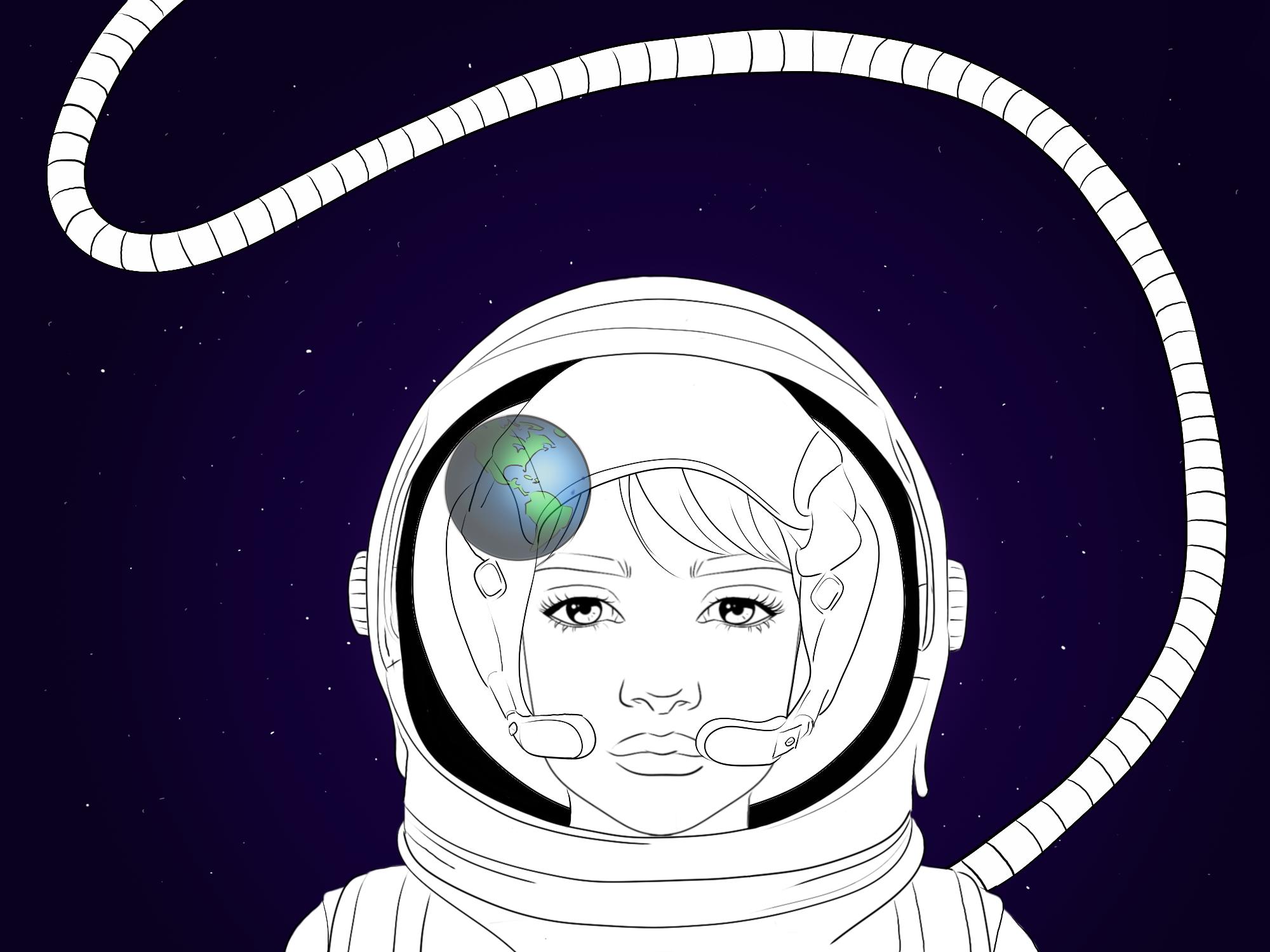
It is a technological world that we live in. Alongside smartphones, artificial intelligence and quantum computers, a new era is arising that might change the way we perceive life itself – the era of space exploration. With such big potential come big obstacles, surprisingly so, ones that will fall into the hands of the behavioural sciences. Next time a crew of astronauts is sent to Mars, they might need a psychologist on board.
It is a technological world that we live in. Alongside smartphones, artificial intelligence and quantum computers, a new era is arising that might change the way we perceive life itself – the era of space exploration. With such big potential come big obstacles, surprisingly so, ones that will fall into the hands of the behavioural sciences. Next time a crew of astronauts is sent to Mars, they might need a psychologist on board.

Illustration by Nina Kollof

Illustration by Nina Kollof
Back when I was a high school senior choosing my university major, I was torn between two fields that I find crucial for unlocking the meaning of life – understanding the human mind and understanding the universe. As such, my excitement for the rise of long-term spaceflight is immeasurable. Naturally, I looked for ways in which I can still intertwine my passion for and knowledge in psychology with space exploration. To my pleasant surprise, I discovered my passions can be combined in the field of space psychology. Unfortunately, the field is highly unknown. So, what is space psychology?
Space psychology is quite an encompassing term, referring at large to applying psychological insight into space exploration. Interesting and relevant fields of psychology are mostly organizational psychology topics such as ergonomics, psychological individual preparation, team selection, training, and management, as well as topics from social psychology, such as cultural differences and group dynamics. Lastly, the issues of loneliness and depression that arise in confined environments are quite prominent and of large interest to clinical psychology.
Space exploration has been quite a hot topic lately, with ‘space tourism’ on the rise and NASA’s planned mission to Mars to be executed by the 2030s (Danes, 2014). Very recently, a SpaceX rocket took flight, carrying four passengers, and orbited space for three whole days (Chang, 2021)! Major aerospace companies such as SpaceX, Blue Origin and Virgin Galactic are all aiming to make commercial spaceflight just as accessible as plane flight (Kessler, 2021).
“The problems of emotional stability, the potential for poor intergroup relations, and leadership in highly demanding environments all may lead to a life-or-death situation.”
However, as technology advances, the human brain lags behind. In fact, human factors are already a focal point of a related domain – aviation. Nowadays statistical research in aviation has discovered, despite the differences being small, that human error is slightly more, or at least just as much of a causal influence on accidents as technical failure (Hobbs, 2004). In addition, another paper has demonstrated the important relationship between individual performance, such as judgement and decision-making, and the consideration of safety practices. For example, policies that concern prevention of error must recognize human factors such as stress and behaviour as an important part of safety regulation (Aurino, 2000). Not surprisingly, the topic of new policy regulations that regard countering stressors and promoting crew health is also prominent in spaceflight. A very recent paper by Ephimia Morphew, a human systems engineer at NASA, describes how the potential for longer-duration space flights in the near future will introduce new human-related stressors. Such stressors include limited sleep facilities and communication with the external environment, technological challenges (in microgravity conditions), isolation, multicultural issues, little possibility for rescue and many others (Morphew, 2020).
We are only human, after all, and we face the difficulty of performing well under stress on a daily basis. However, very few of us have tackled the challenge of performing tasks while floating about in zero gravity, surrounded by nothing but loud machinery and darkness. Space might be vast and endless, but allows very little room for mistakes. The problems of emotional stability, the potential for poor intergroup relations, and leadership in highly demanding environments all may lead to a life-or-death situation when astronauts find themselves isolated so far away from home (NASA, 2014). It is interesting to note that these problems are not limited to space travel, and have been faced by those partaking in arctic expeditions and underwater exploration. All these issues are covered by another related field, known as confined environment psychology, a subcategory of environmental psychology. Findings from this field showcase that severe neurological and psychosocial impact can result from prolonged isolation and limited human interaction, such as separation anxiety (Kanas, 2016), decrements in cohesiveness (Nicolas, et al., 2016), and depression (Suedfeld & Steel, 2000).
“Spaceflight is perhaps the most ambitious project that will stretch the human mind and body’s abilities to the maximum limit.”
Furthermore, as crews become more diverse and space missions grow internationally, better coordination and communication would be needed to avoid stressors from conflict and to enable workforce stability and a unified organizational culture (Broniatowski, Faith & Sabathier, 2006). As such, space exploration presents an opportunity for the unification of the world on a quite ambitious level. In the book ‘’Psychology of Space Exploration’’ (NASA, 2014), it is suggested that an open-systems approach should be adopted to address individual, small groups and organizational behaviour, in order to understand and aid teams of astronauts in such difficult environments (NASA, 2014). Such an approach entails understanding groups as systems, examining their interdependence and how they operate as a team, as opposed to how individuals perform independently (Henman, 2019). This is necessary, due to the highly risk-filled nature of spaceflight, and the need to be able to depend on others for successful long-term missions.
Spaceflight is perhaps the most ambitious project that will stretch the human mind and body’s abilities to the maximum limit. However, despite all the above-listed challenges, there is hope. Morphew (2020) describes that the human factor issues can be tackled by space psychology, and future spaceflight missions can be supported, firstly by better psychological selection of crew members. Currently, tools are being assessed and validated for selection of psychologically better-equipped astronauts, and some of the personality variables that are being assessed are The Big Five (Gosling, Rentfrow & Swann Jr, 2003), empathy, sociability, and most importantly – flexibility under stressful conditions, decision-making and ability to handle (multicultural) conflict. Secondly, psychology can provide astronauts with psychological training by building healthy coping skills against stressful environments, improving communication with crewmembers and offering education on leadership styles. Thirdly, during spaceflight itself, astronauts can be granted psychological support. This involves monitoring of their psychological, emotional and cognitive states by ground-based psychologists, sufficient provision with distractors and entertainment (such as books, films, leisure activities) and enough contact with family and friends, perhaps even providing the family with opportunities to send care packages to their loved one in space, as done during Mir Space I missions (Morphew, 1997).
Aerospace flights are exciting, but also probably one of the most difficult fields to develop in terms of safety. With the stakes raised so high, human error presents a bigger, more probable danger than technological failure. Therefore, rigorous training is needed not only for the physical body but also for the mind. For the aspiring psychologist, this could be an especially intriguing field of work to look into. <<
References
– Aurino, D. E. M. (2000). Human factors and aviation safety: What the industry has, what the industry needs. Ergonomics, 43(7), 952-959.
– Broniatowski, D. A., Faith, G. R., & Sabathier, V. G. (2006). The case for managed international cooperation in space exploration. Center for Strategic and International Studies, 18(1), 1-7.
– Chang, K. (2021, September 18). SpaceX Launches Astronaut Crew Like No Other on Orbital Adventure. The New York Times. https://www.nytimes.com/2021/09/15/science/spacex-inspiration4-orbit.html
– Daines, G. (2014, December 1). NASA’s Journey to Mars. NASA. https://www.nasa.gov/content/nasas-journey-to-mars
– Gosling, S. D., Rentfrow, P. J., & Swann Jr, W. B. (2003). A very brief measure of the Big-Five personality domains. Journal of Research in personality, 37(6), 504-528.
– Henman, L. (2019, November 15). Groups as Systems. Henman Performance Group. https://henmanperformancegroup.com/communication/groups-as-systems/
– Hobbs, A. (2004). Human factors: the last frontier of aviation safety?. The International Journal of Aviation Psychology, 14(4), 331-345.
– Kanas, N. (2016). Psychiatric Issues in Space. Psychiatric Times. https://www.psychiatrictimes.com/authors/nick-kanas-md
– Kessler, S. (2021, September 19). The Week in Business: A Milestone in Space Tourism. The New York Times. https://www.nytimes.com/2021/09/19/business/the-week-in-business-space-tourism-taxes-booster-shots.html
– Morphew ME, MacLaren S, Herring L, et al. Voyage of discovery: American astronauts aboard Russia’s Mir Space Station. Journal of Human Performance in Extreme Environments 1997; 2: 39-61.
– Morphew, E. (2001). Psychological and human factors in long duration spaceflight. McGill Journal of Medicine, 6(1).
– NASA. (2014). Psychology of Space Exploration. CreateSpace.
– Nicolas, M., Bishop, S. L., Weiss, K., & Gaudino, M. (2016). Social, occupational, and cultural adaptation during a 12-month wintering in Antarctica. Aerospace medicine and human performance, 87(9), 781-789.
– Suedfeld, P., & Steel, G. D. (2000). The environmental psychology of capsule habitats. Annual review of psychology, 51(1), 227-253.
Back when I was a high school senior choosing my university major, I was torn between two fields that I find crucial for unlocking the meaning of life – understanding the human mind and understanding the universe. As such, my excitement for the rise of long-term spaceflight is immeasurable. Naturally, I looked for ways in which I can still intertwine my passion for and knowledge in psychology with space exploration. To my pleasant surprise, I discovered my passions can be combined in the field of space psychology. Unfortunately, the field is highly unknown. So, what is space psychology?
Space psychology is quite an encompassing term, referring at large to applying psychological insight into space exploration. Interesting and relevant fields of psychology are mostly organizational psychology topics such as ergonomics, psychological individual preparation, team selection, training, and management, as well as topics from social psychology, such as cultural differences and group dynamics. Lastly, the issues of loneliness and depression that arise in confined environments are quite prominent and of large interest to clinical psychology.
Space exploration has been quite a hot topic lately, with ‘space tourism’ on the rise and NASA’s planned mission to Mars to be executed by the 2030s (Danes, 2014). Very recently, a SpaceX rocket took flight, carrying four passengers, and orbited space for three whole days (Chang, 2021)! Major aerospace companies such as SpaceX, Blue Origin and Virgin Galactic are all aiming to make commercial spaceflight just as accessible as plane flight (Kessler, 2021).
“The problems of emotional stability, the potential for poor intergroup relations, and leadership in highly demanding environments all may lead to a life-or-death situation.”
However, as technology advances, the human brain lags behind. In fact, human factors are already a focal point of a related domain – aviation. Nowadays statistical research in aviation has discovered, despite the differences being small, that human error is slightly more, or at least just as much of a causal influence on accidents as technical failure (Hobbs, 2004). In addition, another paper has demonstrated the important relationship between individual performance, such as judgement and decision-making, and the consideration of safety practices. For example, policies that concern prevention of error must recognize human factors such as stress and behaviour as an important part of safety regulation (Aurino, 2000). Not surprisingly, the topic of new policy regulations that regard countering stressors and promoting crew health is also prominent in spaceflight. A very recent paper by Ephimia Morphew, a human systems engineer at NASA, describes how the potential for longer-duration space flights in the near future will introduce new human-related stressors. Such stressors include limited sleep facilities and communication with the external environment, technological challenges (in microgravity conditions), isolation, multicultural issues, little possibility for rescue and many others (Morphew, 2020).
We are only human, after all, and we face the difficulty of performing well under stress on a daily basis. However, very few of us have tackled the challenge of performing tasks while floating about in zero gravity, surrounded by nothing but loud machinery and darkness. Space might be vast and endless, but allows very little room for mistakes. The problems of emotional stability, the potential for poor intergroup relations, and leadership in highly demanding environments all may lead to a life-or-death situation when astronauts find themselves isolated so far away from home (NASA, 2014). It is interesting to note that these problems are not limited to space travel, and have been faced by those partaking in arctic expeditions and underwater exploration. All these issues are covered by another related field, known as confined environment psychology, a subcategory of environmental psychology. Findings from this field showcase that severe neurological and psychosocial impact can result from prolonged isolation and limited human interaction, such as separation anxiety (Kanas, 2016), decrements in cohesiveness (Nicolas, et al., 2016), and depression (Suedfeld & Steel, 2000).
“Spaceflight is perhaps the most ambitious project that will stretch the human mind and body’s abilities to the maximum limit.”
Furthermore, as crews become more diverse and space missions grow internationally, better coordination and communication would be needed to avoid stressors from conflict and to enable workforce stability and a unified organizational culture (Broniatowski, Faith & Sabathier, 2006). As such, space exploration presents an opportunity for the unification of the world on a quite ambitious level. In the book ‘’Psychology of Space Exploration’’ (NASA, 2014), it is suggested that an open-systems approach should be adopted to address individual, small groups and organizational behaviour, in order to understand and aid teams of astronauts in such difficult environments (NASA, 2014). Such an approach entails understanding groups as systems, examining their interdependence and how they operate as a team, as opposed to how individuals perform independently (Henman, 2019). This is necessary, due to the highly risk-filled nature of spaceflight, and the need to be able to depend on others for successful long-term missions.
Spaceflight is perhaps the most ambitious project that will stretch the human mind and body’s abilities to the maximum limit. However, despite all the above-listed challenges, there is hope. Morphew (2020) describes that the human factor issues can be tackled by space psychology, and future spaceflight missions can be supported, firstly by better psychological selection of crew members. Currently, tools are being assessed and validated for selection of psychologically better-equipped astronauts, and some of the personality variables that are being assessed are The Big Five (Gosling, Rentfrow & Swann Jr, 2003), empathy, sociability, and most importantly – flexibility under stressful conditions, decision-making and ability to handle (multicultural) conflict. Secondly, psychology can provide astronauts with psychological training by building healthy coping skills against stressful environments, improving communication with crewmembers and offering education on leadership styles. Thirdly, during spaceflight itself, astronauts can be granted psychological support. This involves monitoring of their psychological, emotional and cognitive states by ground-based psychologists, sufficient provision with distractors and entertainment (such as books, films, leisure activities) and enough contact with family and friends, perhaps even providing the family with opportunities to send care packages to their loved one in space, as done during Mir Space I missions (Morphew, 1997).
Aerospace flights are exciting, but also probably one of the most difficult fields to develop in terms of safety. With the stakes raised so high, human error presents a bigger, more probable danger than technological failure. Therefore, rigorous training is needed not only for the physical body but also for the mind. For the aspiring psychologist, this could be an especially intriguing field of work to look into. <<



